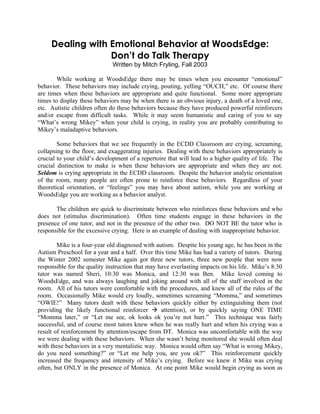
Dealing with emotional behavior
- 1. Dealing with Emotional Behavior at WoodsEdge: Don’t do Talk Therapy Written by Mitch Fryling, Fall 2003 While working at WoodsEdge there may be times when you encounter “emotional” behavior. These behaviors may include crying, pouting, yelling “OUCH,” etc. Of course there are times when these behaviors are appropriate and quite functional. Some more appropriate times to display these behaviors may be when there is an obvious injury, a death of a loved one, etc. Autistic children often do these behaviors because they have produced powerful reinforcers and/or escape from difficult tasks. While it may seem humanistic and caring of you to say “What’s wrong Mikey” when your child is crying, in reality you are probably contributing to Mikey’s maladaptive behaviors. Some behaviors that we see frequently in the ECDD Classroom are crying, screaming, collapsing to the floor, and exaggerating injuries. Dealing with these behaviors appropriately is crucial to your child’s development of a repertoire that will lead to a higher quality of life. The crucial distinction to make is when these behaviors are appropriate and when they are not. Seldom is crying appropriate in the ECDD classroom. Despite the behavior analytic orientation of the room, many people are often prone to reinforce these behaviors. Regardless of your theoretical orientation, or “feelings” you may have about autism, while you are working at WoodsEdge you are working as a behavior analyst. The children are quick to discriminate between who reinforces these behaviors and who does not (stimulus discrimination). Often time students engage in these behaviors in the presence of one tutor, and not in the presence of the other two. DO NOT BE the tutor who is responsible for the excessive crying. Here is an example of dealing with inappropriate behavior. Mike is a four-year old diagnosed with autism. Despite his young age, he has been in the Autism Preschool for a year and a half. Over this time Mike has had a variety of tutors. During the Winter 2002 semester Mike again got three new tutors, three new people that were now responsible for the quality instruction that may have everlasting impacts on his life. Mike’s 8:30 tutor was named Sheri, 10:30 was Monica, and 12:30 was Ben. Mike loved coming to WoodsEdge, and was always laughing and joking around with all of the staff involved in the room. All of his tutors were comfortable with the procedures, and knew all of the rules of the room. Occasionally Mike would cry loudly, sometimes screaming “Momma,” and sometimes “OWIE!” Many tutors dealt with these behaviors quickly either by extinguishing them (not providing the likely functional reinforcer attention), or by quickly saying ONE TIME “Momma later,” or “Let me see, ok looks ok you’re not hurt.” This technique was fairly successful, and of course most tutors knew when he was really hurt and when his crying was a result of reinforcement by attention/escape from DT. Monica was uncomfortable with the way we were dealing with these behaviors. When she wasn’t being monitored she would often deal with these behaviors in a very mentalistic way. Monica would often say “What is wrong Mikey, do you need something?” or “Let me help you, are you ok?” This reinforcement quickly increased the frequency and intensity of Mike’s crying. Before we knew it Mike was crying often, but ONLY in the presence of Monica. At one point Mike would begin crying as soon as
- 2. he saw Monica, and stop as soon as she left. At this time she finally began to take her TAs feedback seriously, and stopped attempting to do talk therapy with a young child who was hardly vocal. Mike’s crying behavior was done within 2 sessions…rarely to be seen again. Here are some possible diagrams of these contingencies that may increase and decrease inappropriate “emotional” behavior at WoodsEdge. Possible reinforcement contingency: Mikey does not Mikey has have comforting comforting statements from Mikey cries statements from his tutor his tutor Possible Escape contingency: Mikey is in a Mikey is not in a demanding demanding academic Mikey cries academic situation situation Possible Avoidance Contingency: Mikey will be in a Mikey will not be demanding in a demanding academic academic situation in 2 Mikey cries situation in 2 minutes minutes